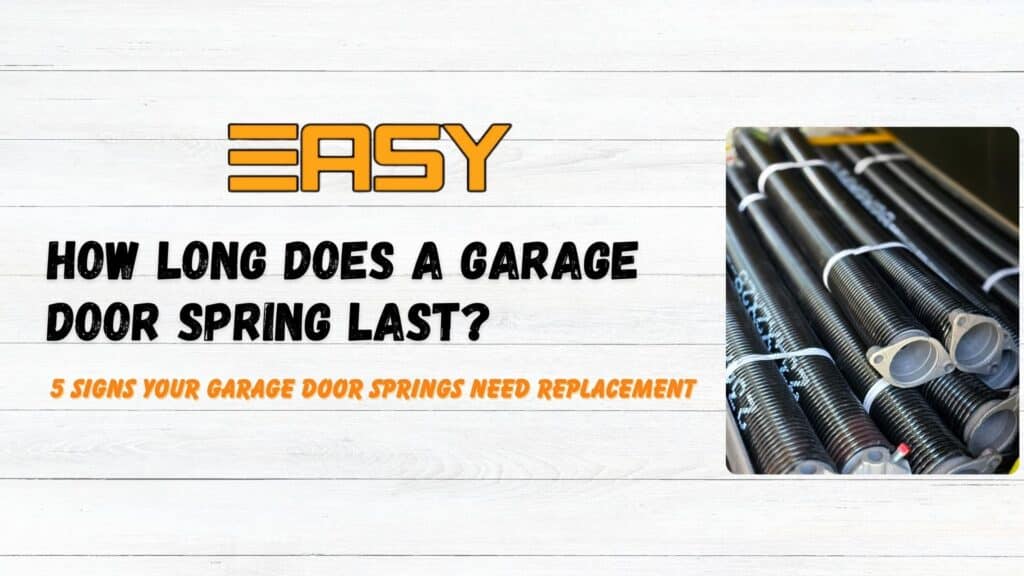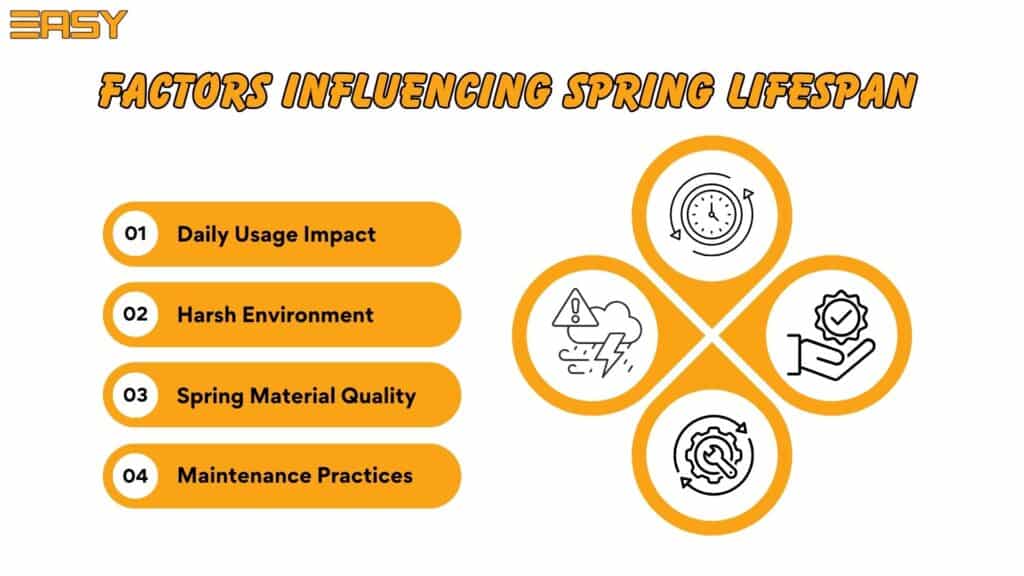
Garage door springs are vital parts that ensure the garage door operates properly. Generally, these springs are made to endure about 10,000 open and close cycles, which means they last, on average, seven to ten years. But sometimes, they don’t last that long, or they last longer, based on two basic variables: what kind of spring it is and how well it’s maintained.
Generally, torsion springs are designed to last longer than extension springs. The reason is simple: when it comes to garage door spring design, distribution is king. In a well-engineered system, tension, torque, and other forces should be distributed evenly throughout the mechanisms of the system.
A garage door spring should not live under “the real MVP” director of spring-life conditions. If by some miracle it does, the lifespan of the spring should provide a clear warning sign. Here are a few reasons to ponder, and to work around. See if you can apply each one to your next set of “how-to” fresh-baked memories.
How Long Does a Garage Door Spring Last?
Springs are vital parts for the garage door to work as intended. Their lifespan is determined mainly by what kind of spring it is and how often the door is used. In general, the lifespan of the garage door spring is 5-12 years.
Lifespan of Torsion Spring
The most current use of spring torsion in garage doors, if contemporary, is considered what is currently in use. Positioned above the door, on a metal shaft, these springs twist to accumulate energy when the door is closed. Torsion springs’ stored energy then raises the garage door when it is opened.
Torsion springs generally last from 7 to 12 years or from 10,000 to 20,000 cycles; a cycle is one complete opening and closing of the door. They employ a twisting motion that distributes the weight of the door evenly so that it opens and closes without much effort. This equates to a lifespan of about 10,000 to 20,000 cycles, with a cycle defined as one complete opening and closing of the door.
Lifespan of Extension Spring
Extension springs are installed on both sides of the garage door and function by stretching and contracting to facilitate the door’s movement. These springs store energy when they stretch while the door is closing and release this energy to assist in opening the door.
The lifespan of extension springs is usually shorter than that of torsion springs. They generally last up to 10,000 cycles, which correlates with the typical lifespan of about 5 to 7 years. The stretching and contracting movements exert additional stress on these springs, resulting in more wear over time and thereby limiting their longevity..
Factors Influencing Spring’s Lifespan
The lifespan of garage door springs is determined by several key factors. Knowing what these are allows me to work toward ensuring efficient operation of my garage door system and, as a result, plan for replacements only when necessary.

Daily Usage Impact
Garage door springs have a much shorter lifespan if the door is used frequently. With what I refer to as the base unit of measurement, the base unit is one complete opening or closing of the door. The locked-in number of cycles that the average garage door spring can handle is around 10,000. Opening and closing the door 10,000 times only wears down the kind of spring that was okay to wear down when it first went in. After 10,000, my door hasn’t got much left.
- Opening the door twice a day: Springs may last around 14 years.
- Opening the door four times a day: Lifespan is reduced to about seven years.
- Opening the door eight times a day: Replacement may be needed in just 3 to 5 years.
Environmental Factors
Garage door springs are vulnerable to the most severe weather. In places where the climate is as harsh as that of Houston, the increase in rust and corrosion can easily compromise the springs. Cold weather can render them brittle and much more likely to break; conversely, heat can expand them in ways that make them less effective at doing the one job they have—holding the door up when it’s supposed to be up.
Material and Quality
The durability of a garage door spring is directly affected by the stuff it’s made of and the way it’s made. If it’s made from good, high-quality materials, it’s probably going to last longer than something that’s poorly designed and poorly made. And if the spring itself is made from good, low-corrosion stuff, it’s going to perform better than a spring that’s on the verge of breaking and winding up costing me a pretty penny in maintenance and the silly inconvenience of a door that won’t open or close.
Maintenance Practices
Maintenance that is done well is the key to extending the lifespan of garage door springs. What can you do to keep your springs in good shape? You can perform regular lubrication, inspection for damage, and you can tighten any loose hardware that may be present. If you do these things and the undefined acts of good maintenance, you will probably avoid premature spring failure. That is, the whole-door system will operate smoothly and reliably for years to come.
5 Signs Your Garage Door Springs Need Replacement
Recognizing the signs that your garage door springs need replacement is essential for ensuring safety and functionality. Here are five critical indicators to watch for.
1. The Garage Door Feels Heavy or Won’t Stay Open
An early warning sign of failing springs is difficulty lifting the door. Garage door springs are designed to counterbalance the door’s weight for effortless operation. If you experience any of the following:
- The door feels unusually heavy
- The door doesn’t stay open, but slowly slides down
- You struggle to lift the door manually
2. Loud Bang or Snapping Noise
A sudden loud bang in the garage often signals a broken spring. High-tension springs can snap, releasing energy that produces a noticeable sound when they fail. If you hear this noise, inspect the springs for any signs of breakage or disconnection immediately.
3. Uneven or Unbalanced Movement of the Door
A properly functioning garage door should open and close smoothly. If you notice the door moving unevenly or jerking, this indicates an issue with one or more springs. Uneven tension in the springs can place excessive strain on the garage door opener and other components, necessitating immediate replacement to prevent further damage.
4. Visible Gaps in the Spring
Healthy springs are tightly wound. Regular inspection of the springs for visible defects is crucial. Signs that indicate a spring needs prompt replacement include:
- Gaps between coils
- Fraying or cracks
- A completely broken spring
5. Rusty or Stretched Spring
Rust buildup significantly weakens metal and accelerates wear and tear. If a spring appears stretched or shows visible rust patches, it poses a risk of failure. Applying a silicone-based lubricant regularly can prevent rust and help prolong the lifespan of your garage door springs.
Importance of Timely Professional Garage Door Spring Replacement
Replacing garage door springs on time keeps the door safe and functional. Worn springs can cause the door to fall, creating unsafe situations. Regular maintenance prevents hazards and ensures smooth operation.
Hiring our professionals for spring replacements is safer, as springs are under high tension and require expertise. We ensure the entire system works properly, improving safety and durability.
Though DIY is an option, professional help is recommended. High-quality springs and proper care can extend the lifespan of your garage door and keep it running smoothly for years.








